Raising minimum standards of external building quality in designated revitalization corridors will help to improve the appeal of the overall streetscape and reinforce the investments made by others.
By Chris Higgins
Published December 04, 2014
The 'Broken Windows Theory' comes from the work of Kelling and Wilson, two criminologists who in 1982 related incidences or the potential for crime to the quality of the built environment. They argued that:
Social psychologists and police officers tend to agree that if a window in a building is broken and is left unrepaired, all the rest of the windows will soon be broken. This is as true in nice neighborhoods as in run-down ones. Window-breaking does not necessarily occur on a large scale because some areas are inhabited by determined window-breakers whereas others are populated by window-lovers; rather, one unrepaired broken window is a signal that no one cares, and so breaking more windows costs nothing.
This theory has been adopted in many cities as a crime reduction strategy, most famously across New York City by Mayor Giuliani as part of the controversial 'stop-and-frisk' policy.
But while it is primarily focused on crime (several studies have shown that such policies have led to reductions in crime, while others are critical of these findings), the theory easily extends beyond preventing criminal activity to the notion of the overall quality of the built environment, our interactions with it, and neighbourhood investment and revitalization.
The basic idea is that one broken window leads to more broken windows, one graffito to more graffiti, and one piece of trash to a street littered with garbage. An unkempt street gives off negative perceptions.
On the other hand, an attractive street is one that tenants, homeowners and business owners can be proud of and can potentially foster greater economic growth and revitalization. Essentially, a street that looks cared for is cared for.
To help ensure commercial properties have high-quality storefronts, the City of Hamilton has a façade improvement program for building owners within a Business Improvement Areas (BIA) that covers up to a maximum of $25,000 for renovations depending on the frontage of the building.
A further $10,000 is available for "Artfully designed façade improvements or art pieces placed on private property". Such programs are certainly important for inducing the type of high-visibility improvements that can improve not only a single property but overall perceptions of the street.
However, not all of the city's commercial corridors fall within a BIA, including much of James Street North for example, and even within a BIA there are many examples of building owners who show little interest in improving their properties.
Furthermore, the existing Property Standards By-law allows vacant buildings to have their windows and doors covered by plywood, though windows do have to be "painted matte black to resemble window glass" and doors have to match the building.
In response, I am going to argue that the City should now embark on a larger corridor revitalization program, one in which a 'no broken windows' exterior improvements policy should be made mandatory within designated areas.
My focus for this article is James Street North, which has seen a great deal of reinvestment and revitalization over the previous decade. Still, there appear to be several examples that undermine overall area improvements made by others and persistently hold the street back from realizing its full potential.
To help make my case, we first turn to some theory (I am an academic after all!).
In economics, a first-mover advantage is one where the initial occupant in a segment of the economy sees an advantage by virtue of being first. The head-start against potential competitors can provide them more opportunities to control resources or gain customers and market share and earn large profits.
In contrast, a second-mover advantage is one where the large potential profits accrue to those who follow the lead of the first-mover and enter the market later.
This occurs when the first-mover faces high research and development, marketing, and education costs associated with bringing a new product to market. Rather than expend the capital do it themselves, the second-movers can simply 'piggyback' on these investments.
In many ways the economics of property development in an urban area that is undergoing gentrification through new reinvestment and revitalization such as James Street North are largely reflective of a second-mover advantage.
To see this at work, let's look at the timeline of gentrification according to David Ley, a noted gentrification scholar at the University of British Columbia:
We can think of each of the four phases as loosely resembling the 'movers', with each building on the efforts of the last.
For property development, developers (and their lenders) are generally risk-averse, in that they will not risk entering a market and investing millions of dollars into a new project until demand is proven and potential profits exceed the cost of construction.
But as gentrification takes place, demand among individuals and businesses to locate in an area increases, which in turn drives up land values and makes projects more viable.
To put this in terms of the timeline of gentrification, phase one is largely concentrated on reinvestment in the existing housing stock.
In phase two, this can shift to redevelopment or small-scale new development where some developers with higher tolerances for risk will see the potential in a neighbourhood and hopefully see a small profit on their project.
Finally, phases three and four are marked by larger-scale redevelopment and new-build projects that become more profitable as demand and land values increase.
In this sense, the actions of early individuals make it more profitable for second- and third-movers down the line. Of course, first-movers who own property in the neighbourhood will also see an advantage through higher profits as the neighbourhood continues to evolve.
But what I want to focus on is the most extreme case of a second-mover advantage in which individuals or businesses that do not directly participate in the gentrification process benefit from the investment of other individual's capital (whether it be the sweat-equity involved in fixing up a property or a new multi-million dollar condominium development) into a neighbourhood.
Take the example of James Street North. The street could be characterized as somewhere in the late second phase or early third phase of gentrification. A great deal of reinvestment in the existing building stock has occurred as evidenced in this row of buildings immediately north of Cannon:
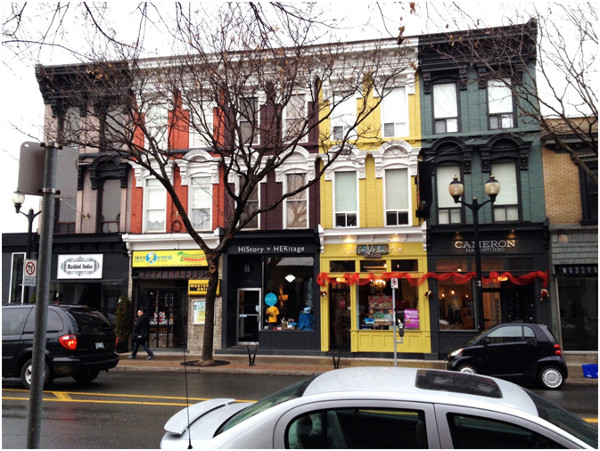
James North streetwall immediately north of Cannon
Just down the street, new investment is occurring on the corner of James North and Vine. Elsewhere, one can see advertisements for three new condominium projects along the street, signifying a turning point for new development.
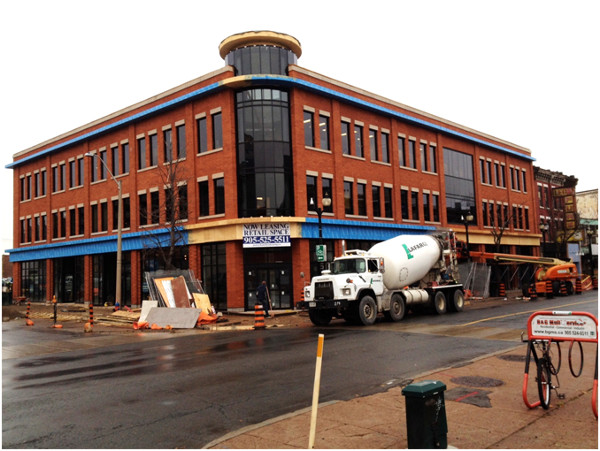
New development at James North and Vine
Even what I have come to (lovingly) refer to as 'Ca$h-4-U Corner' is seeing reinvestment by building owners:
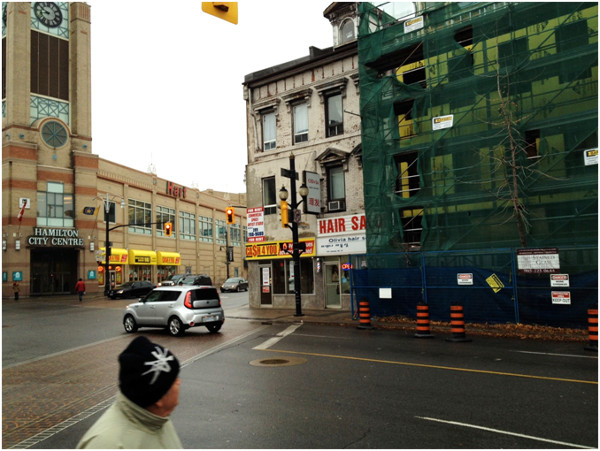
Renovations at James North and York
Yet in the middle of these examples stands the row of buildings at James North south of Cannon where much of the front façade consists of boarded up windows and doors.
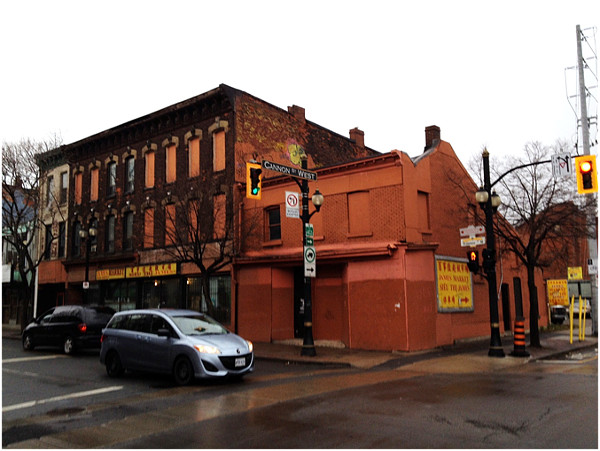
Boarded-up buildings south of Cannon
One can see similar examples at several locations along the street. On my walk today I encountered boarded up windows at James North and Colbourne:
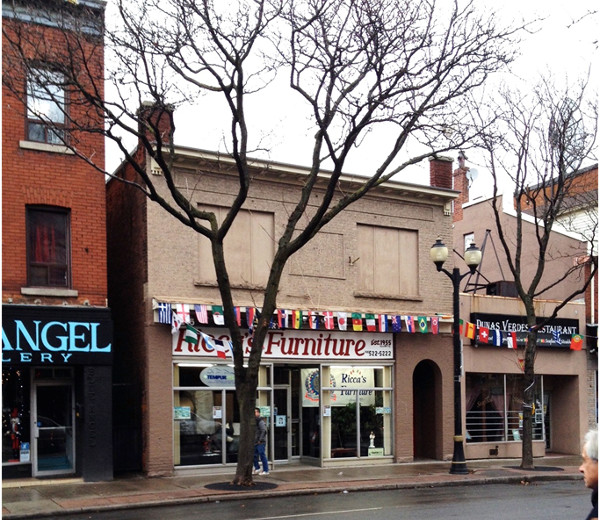
Boarded-up windows at James and Colbourne
Boarded windows at James North and King William:
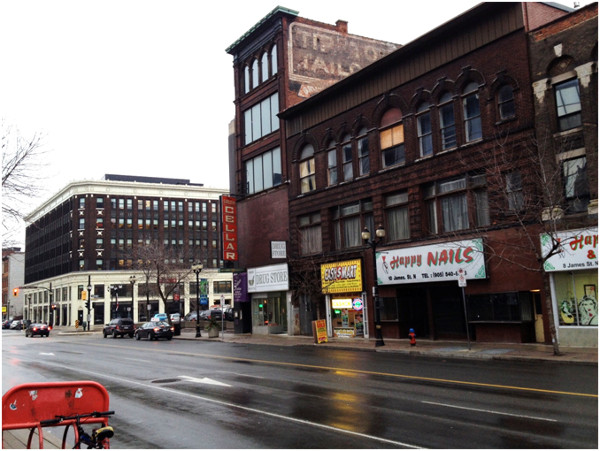
Boarded windws at James and King William
And boarded and broken windows at James North and Rebecca near the Lister Block and the future Artizen condominiums site:
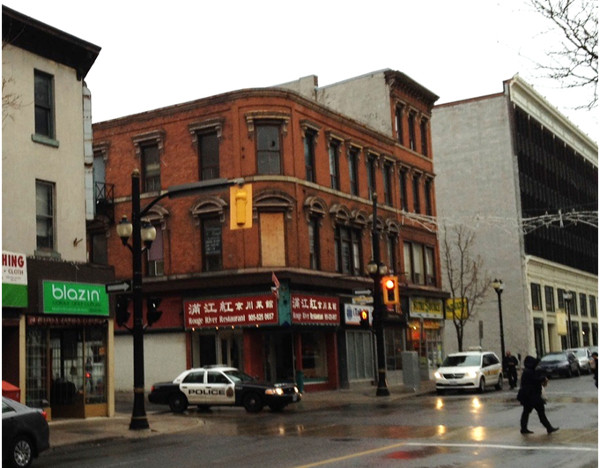
Boarded and broken windows at James and Rebecca
Assuming they are vacant, many of these examples appear to meet existing property standards by-laws. However, the issue is their larger effect on the quality of the overall built environment and the continued revitalization of the street.
Such examples present a situation in which their owners are benefitting from the reinvestment that has taken place in neighbouring properties while at the same time doing little to contribute to the larger changes occurring along the street, arguably even eroding the progress made by others.
To begin to overcome this issue, a mandatory 'No Broken Windows' policy should be adopted. Even if vacant, all window openings should have a window in them. Matte dark paint should no longer suffice as the minimum standard in these important corridors.
Such a by-law can encourage property owners to engage in high-visibility improvements to their buildings that promote a more attractive built environment and contribute to the feedback loop of positive neighbourhood reinvestment and revitalization that has and continues occur along the street.
There will always be some degree of second- and third-mover advantage in neighbourhood redevelopment and gentrification and little we can do to control how someone uses the inside of a building.
However, even if it is superficial, enforcing new minimum standards of external building quality such as no broken or boarded windows in designated revitalization corridors such as James Street North will do much to improve the appeal of the overall streetscape and reinforce the investments made by others.
These actions may even induce property owners to make further reinvestments in their own buildings rather than doing little to maintain them while they speculate on the greater returns that may accrue from the efforts of larger neighbourhood revitalization.
When there was talk earlier this year about the seemingly imminent demolition of the row of buildings facing Gore Park, I remember reading a remark about how removing these buildings would put a gap in the smile of the city's downtown.
With the Juno Awards utilizing James North as the city's Juno Zone, there is no better time to ensure we put our best foot forward for the rest of Canada to see.
By Desmond (anonymous) | Posted December 04, 2014 at 13:55:26
How about getting the province to fix their windows at the Ellen Fairclough building first?
By johnny velvet (anonymous) | Posted December 04, 2014 at 15:47:54
For those that lived in this community in the early days...I would love to see the south-end of Cannon "unboarded". It was one of the last old school barbershops in the city...candycane barber pole and everything. I wonder if it has any of the old equipment left behind. I think it shuttered up around the early to mid 90s...the same time Bi-Way (one building over) closed.
By mel (registered) | Posted December 04, 2014 at 16:54:08
The problem with the Broken Window approach is that it requires good will with both carrots and sticks across many levels of our citizenry, from city officials to police to the voting public. It takes a strong commitment to stand up to absent/neglectful landlords and taxpaying citizens alike; those charged with enforcing such policies have to know that they have the full support of the public and not be swayed by those vocal few who don't want to bring their properties up to standard.
It's not just commercial properties that fall short...a walk in either direction from my East Hamilton home will reveal at least 1 out of every 10th home in desperate need of adhering to current property standards, let alone Broken Windows standards.
Not for the faint of heart.
By eyerolling (anonymous) | Posted December 04, 2014 at 20:11:15 in reply to Comment 106586
we should outlaw building supply stores because renovating properties is evil
grow up
By higgicd (registered) | Posted December 04, 2014 at 18:45:42 in reply to Comment 106586
I had a paragraph in my original draft that noted that I had invoked the dreaded 'G' word, knowing the negative connotations associated with gentrification would get called out down here in the comments. The social exclusion that can happen through the gentrification of an area will always be an issue, in some cities and areas more than others. We could debate the merits all day long of neighbourhood change or stasis, and investment versus decay, and of gentrification in Hamilton versus Vancouver or something. Regardless, I would still argue the original point of neighbourhood appearance and its effect on a number of factors, from crime to economic vibrancy, still stands. And at least have the decency to not comment anonymously when implying racist overtones.
By RobF (registered) | Posted December 05, 2014 at 11:34:09 in reply to Comment 106588
I don't quite share QueenStreetWestOmen's view, but there's a fine line between pretty-city discourse and the ravanchist city.
That said, the bigger issue is why allow the floors above the shops to remain empty ... rather than ask the city to enforce a "broken windows" policy why not advocate for a mandatory occupancy or use policy? Or at least adopt policies that remove any economic incentive to allow such spaces to remain vacant more or less indefinitely. The overall health of the street would improve if these spaces were returned to productive use as residences or small offices.
A "broken windows" approach encourages us to address the symptom of the problem not the problem itself.
By Problem (anonymous) | Posted December 05, 2014 at 12:06:52 in reply to Comment 106602
I guess the problem would be in implementation. How do you force tenants on a landlord or a landlord to take tenants. Such a law would likely be unconstitutional.
By RobF (registered) | Posted December 05, 2014 at 12:25:43 in reply to Comment 106603
Crafting such a policy would be complicated. I would suggest that it could be dealt with partly thru shifting taxation policy ... i.e. remove incentives that encourage the under-utilization of land and properties. There is nothing unconstitutional about that, and other RTH contributors have talked about this with regard to surface parking downtown and totally vacant properties.
By lakeside (registered) | Posted December 05, 2014 at 00:57:14 in reply to Comment 106588
I wasn't suggesting intentional racism but rather using ethnicity as shorthand for those types of businesses that remain on James Street North but which wouldn't likely be described as boutiques.
I get as excited as anyone when I see the latest dingy storefront brought back from indifference to a renewed state of shining glory by owners and tenants; sweet it is when the last in a row of rainbow-coloured facades is finally filled in.
But I worry the type of program that you are suggesting would serve to shorten the timeline between now and that time in the future when James Street North has passed its peak awesomeness, having turned into another strip of chain stores, no room left for the brilliant independents we have now.
That may be hard to imagine from here but it's pretty much inevitable considering the short length of the strip.
Does anyone remember when Hess Village was great? Wasn't that only about a decade ago?
When the winds of gentrification finally take hold of an area, the process tends to occur with ever increasing swiftness.
Why not enjoy the process?
Twenty years from now many of us will be telling stories of how we were there when JSN finally reappeared on the scene. "Oh, but it was so much more authentic then. -- I knew many of the shop owners; some were close friends. -- I even worked to bring back a few of those beauties myself" we'll say. "Yet something has been lost. -- It's not the same since all those chains moved in. -- I could be in almost any city and go to those same stores. -- The employees don't even care, not like the industrious owner/operators who brought JSN back. -- Where did all the good stores go?" If that sounds far fetched go check out Queen Street West in Toronto, University Avenue to Bathurst, the original hip strip of that city. It is not even a shadow of what it was when it was first gentrified, and the period just before.
I worry about places like Mex-I-Can, to drop another ethnic token as stand-in for the type of shop which might be endangered here. If we do go ahead and enact an elevated level of property standards enforcement within our most important commercial areas, then are we prepared to possibly lose gems like this?
Didn't they recently have a brush with a new health inspection regime that saw them close for a day or two? What if they were given 30 days to bring everything up to standard, zero tolerance style? New washrooms, new kitchen, renovated dining room; could they do this?
To be honest, the first time I walked in there, in one look I decided it wasn't a place I would eat at. Fortunately, I did finally try it and in many visits there since have never had anything but the freshest and tastiest food. And this is despite the fact the place doesn't really do much for the eye. They have the best Mexican food I have ever bought here.
Taco Bell has cleaner windows, and they could afford to pay several times the rent that a place like Mex-I-Can could, no doubt, but which one do you want? How long will Mex-I-Can survive in a climate of broken-windows-type enforcement? I don't shop at the Vietnamese wholesaler, or supply my shop, my livelihood, from there but someone does.
Rather than use the blunt force of zero tolerance why not try a different angle? You mentioned carrot and stick. What if we were to try a less rigid approach?
Maybe there are people willing to jazz up some of the more neglected exteriors on a sort of community improvement basis. Many people are disturbed by some of the neglect that remains. Can we turn some of that energy into something positive? What if we offered to implement a cheap and cheerful makeover to those buildings that seem to be left behind; at least at the street level, the first storey?
We have some pretty good organizers around here. There is a spirit of volunteerism throughout the core. There are talented artists everywhere, some of whom may be looking for more exposure. The City is open to things it never would have considered before. There may even be money available there, but if not then companies like Benjamin Moore seem willing to donate paint for worthy community projects.
If the city or owners rebuff the offer of a simple makeover, then do it anyway. A quick coat of paint and some simple murals or colour blocking over the papered and plywooded windows. Guerrilla style if necessary. If a given property owner is absolutely resistant to receiving a makeover, then go zero tolerance all over *them. On an individual basis rather than routing every business below a given level, thereby setting the stage for a corporate takeover of the street.
I'm just trying to say be careful what you ask for, and why not enjoy the ride because these are the golden days of James Street North. There are plenty of golden days ahead but they won't last forever, so why do we have to do this so fast?
By RobF (registered) | Posted December 05, 2014 at 12:10:44 in reply to Comment 106594
What you are getting at has been been called the "suburbanization of the city". Even though I dislike the phrase, because I think it's a distortion and not overly helpful, it is an attempt to describe the perceived loss of urban character and diversity that people feel as older urban neighbourhoods experience super-gentrification, a process that has thus far occurred in a select few global cities (London and NYC, most prominently).
Sharon Zukin tries, with mixed-results, to write about it in her book "Naked City", which is about NYC's transformation under Giuliani and Bloomberg. She laments the same things you do. It's a complicated problem because it is a product of unresolvable tensions created by an aspirational culture, weakly acknowledged class divisions, and private property rights/self-interest.
Comment edited by RobF on 2014-12-05 12:11:33
By Fake Name (anonymous) | Posted December 04, 2014 at 18:21:22 in reply to Comment 106586
You're a dick.
Going straight from building standards to accusations of racism? That's a dick move.
There are plenty of Portuguese-owned and Chinese-owned businesses running just fine on James North. The ones that shuttered are the ones that had half their storefront windows covered in newspaper.
If somebody had a boarded up building next to my house, I don't give a shit about their nationality, I want the eyesore gone.
Obviously, that means I'm racist. Or classist. Or elitist.
Not that I just want to be somewhere actually *nice*.
By fast_eddie (registered) | Posted December 04, 2014 at 21:22:24
I think people are misunderstanding Queen Street's comments. He or she is pointing out that James N., is in line to have massive, (at times detrimental) commercial overhaul as did Toronto's Queen Street W.
An area that was once known for its eclectic appeal, drawing local designers and craftsman...all run by various ethnic mom and pop shops...has been pushed out by big box chain retailers. Like James N now, Queen W had a strong influence of European and Asian operators. Alot of these businesses rented the storefront and therefore the appeal. However, with the economic change and more "bad boy" style leadership in Toronto's City Hall, it saw many odd impositions posed on both the renters and owners, leaving them to abandon the store so that the City took it under tax arrears and then sold to the next condo developer.
QueenStreetWestOmen is actually pointing out the hypocrisy of many that profess to be all for urban revitalization. A quick look at City Hall, and one will notice that many staff actually drive to work. They are not from the core, but rather the suburbs...and sometimes not even Hamilton suburbs! Among these staff, some are making key decisions about what is right for our downtown. This is what QueenStreetWest is pointing out.
Dear QueenStreetWestOmen - I hear your message...I shed a little tear more and more every time I visit TO. I can no longer tell if the Gardiner is a highway or just a really long parking ramp to one of the many condos.
By lakeside (registered) | Posted December 05, 2014 at 01:13:36 in reply to Comment 106590
Thanks, you get it.
When you say '...many odd impositions posed on both the renters and owners...', I think that pretty much captures it.
Like so many things, with gentrification getting there is the truly fun part. There's a certain feeling of loss that comes with having arrived, when you finally do. So let's enjoy the process!
Five years from now we'll be comparing notes while having coffee on Barton. Chimo!
By fast_eddie (registered) | Posted December 05, 2014 at 12:54:01 in reply to Comment 106595
I'm all for enjoying the process...when it's done right. All in all...I'm happy with what's happening in the city. My whole thing was to defend QWO, as I felt some did not really realize what the person was trying to say.
In 5 years time, hopefully the notes compared make up a textbook...if not planning/architectural, at least historical!
By H1 (anonymous) | Posted December 05, 2014 at 15:18:05
Make your property look nice and the Market Value Assessment will increase and the city will reward you by increasing your property taxes. End MVA as a base for tax rates and the properties will get cleaned up. MVA is the dumbest way to set property taxes, they should be based on ability to pay or services offered.
By KevinLove (registered) | Posted December 07, 2014 at 01:03:31 in reply to Comment 106620
And if I pick good stocks that pay higher dividends, I have to pay more income taxes! Same if I get an education and job skills that gets me a good job.
Financial success gets taxed. The alternative is taxing poor people. This tends to not work very well. So I suggest getting used to our present system.
By oldcoote (registered) | Posted December 08, 2014 at 14:41:16 in reply to Comment 106668
Pride of ownership and wealth are not linked. You're assuming that property maintenance requires money, when often, it requires nothing more than elbow grease.
By byron zorzos (anonymous) | Posted December 06, 2014 at 11:24:23
Sounds to me like a squeaky door hinge looking for oil. Go East young man.
By higgicd (registered) | Posted December 07, 2014 at 12:34:34 in reply to Comment 106650
Funny, I thought the same thing after all your whining on twitter after Brad lost.
By Weird (anonymous) | Posted December 07, 2014 at 03:15:54
Let's remember, the best neighbourhoods are mixed use. I personally feel that this applies to commercial as well as residential real estate... meaning, if there aren't grocers and a hardware store, a neighbourhood's a failure.
While I'm thrilled at the changes occurring along James Street North, I'll regret the loss of spots to buy giant cooking pots, fresh fish, or hinges and screws if they occur. And sadly, if this happens, it will likely be because of refugees from areas where it has already occurred (ie. Queen West, etc. et al).
Austin, Portland (et al) cries "Keep us Weird". I say we should strive to "Keep Hamilton Real" and as weird possible!
By samson (anonymous) | Posted December 07, 2014 at 15:43:28
I don't understand how the gentrification timeline or first/ second mover theory has anything to do with the importance of property standards. It's not like property standards force people to upgrade. Are you implying that due to increasing property values caused by increased investments, non-participating owners (who are usually there first) should somehow be forced to upgrade?
By cyrprano (registered) | Posted December 13, 2014 at 13:38:34
While I think some of the theoretical ideas are a bit of a stretch this article presents some interesting ideas about disorder, neighbourhood revitalization, and sense of community. Still it's a bit radical to enforce a 'no broken windows' policy on storefront owners, especially for 'mom and pop' storefronts. For a beautification initiative to work it would take partnership between storefront owners, City of Hamilton, and local BIA's to work together to ensure the street itself and everything this encompasses (which includes storefront facades) is inviting to insiders and outsides. As the author mentions-- this can simply start by showing a sense of pride in the neighbourood. The problem is that this needs community-action NOT the individual action (whether that be financial or elbow grease) of storefront owners alone. Thankfully there is a lot of interesting research happening in this area throughout the City of Hamilton via CRUNCH @ McMaster University, Cobalt Connects, and the local BIA's via the Neighbourhood Action Strategy.
As an academic myself a little data to support these theoretical claims, and to direct the policy initiative being proposed, is required. This includes complementary methods such as statistics (for example- pseudo measures of socio-demographics like CENSUS data), observational (for example- systematic social observation), and qualitative interviews with community-stakeholders (to understand 'perceptions') to provide a birds-eye view and street-level perspective of the neighbourhood(s) under scope, like James Street. Thankfully a starting point could be checking out the methods and data available via Cobalt Connects 'Expressing Vibrancy' project (http://expressingvibrancy.ca/) which provides all kinds of useful data for James Street and 7 other focus neighbourhoods of the Hamilton.
Overall this is an interesting discussion that can add depth to much of the neighbourhood visualization, revitalization and beautification initiatives happening throughout the Hammer.
You must be logged in to comment.
There are no upcoming events right now.
Why not post one?